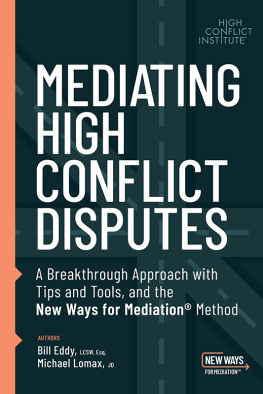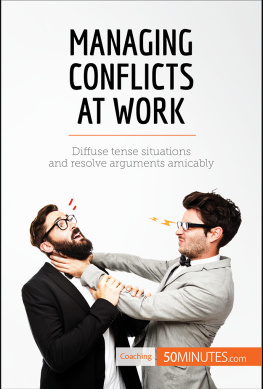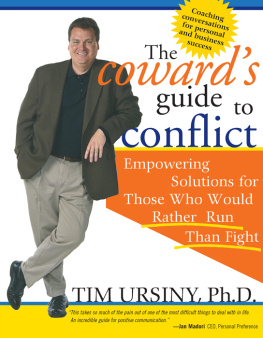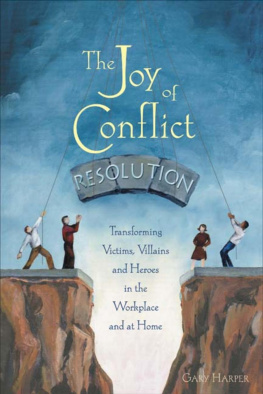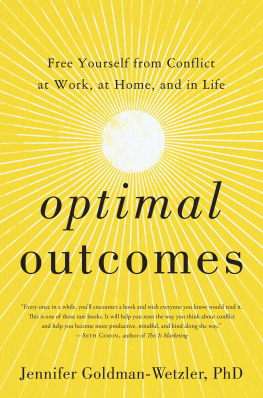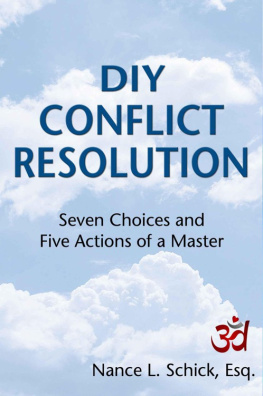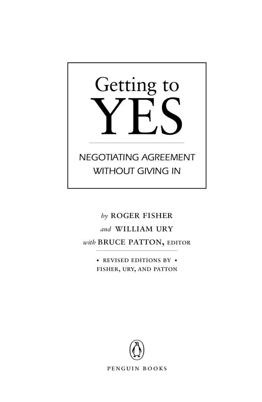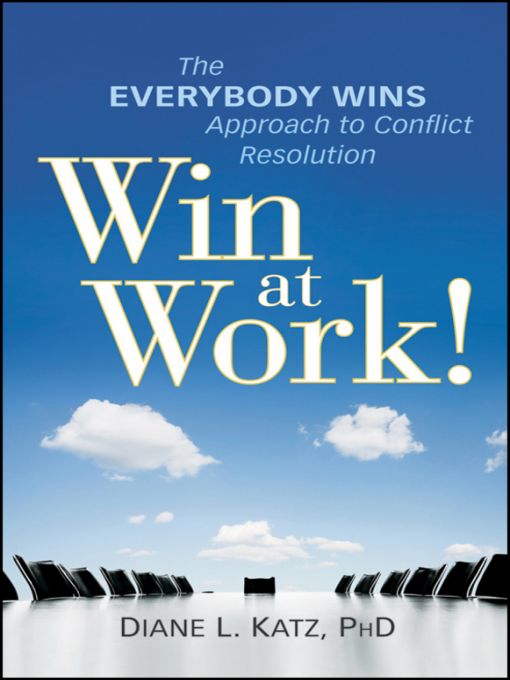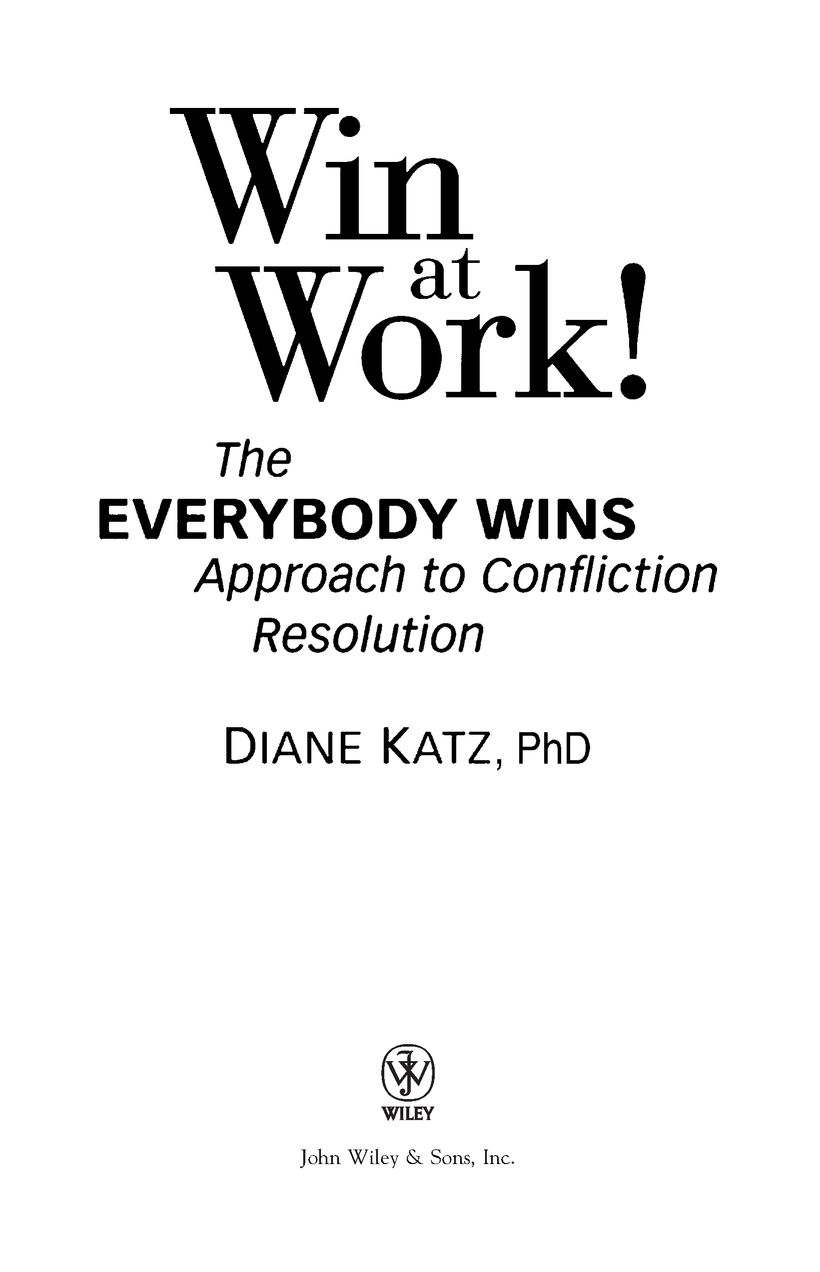Table of Contents
For JLC
The light of my life and the hope of my heart. Thanks to Mom and Dad, for always believing in me. Wish you were here.
Introduction Understanding Conflict at Work
How often do we find ourselves stuck with or frustrated by conflict at work? Far too often! After years of watching organizations struggle to free themselves from destructive conflict, I developed The Working Circle, a step-by-step process that helps men and women resolve workplace conflict in a nonconfrontational, creative, and collaborative way.
Conflict by itself is neither good nor bad. It just is. We cant avoid it; it emerges in every aspect of our lives, every single day, to a greater or lesser extent. Imagine having no conflict at work. At first, you might think what a wonderful experience that would be! But that would be true for a very short period of time; after a while, it would get boring. Why? Because conflict gets our juices flowing; it motivates us to excel. Competition is conflict, after all, and in the business world, we certainly need to be competitive! Without conflict/competition, there would be fewer opportunities for creative thinking, breakthroughs, innovation, and professional growth.
Conflict: Constructive and Destructive
There are two kinds of conflict at work: destructive and constructive. Destructive conflict distracts you from achieving the goals of the organization; it takes your eyes off the prize and puts more focus on covering your butt. If you have a disagreement with someone, for example, most likely you will not resolve the conflict. Instead, you are more likely to talk about that person and the problem to other people, in an attempt to gain allies rather than find solutions.
At one Fortune 100 company where I worked, things werent going very well. Revenues were down, the stock price was plummeting, and morale was at an all-time low. The fear of layoffs was prevalent, causing productivity to drop. Execs were under constant pressure to performto survive. Instead of an atmosphere of collaborative teamwork, an every man for himself attitude took over. People began exhibiting negative behaviors with regularity; colleagues provided insufficient data to one another; teams were pitted against each other; and lying became widespread. In response, leaders looked the other way, because they were struggling to survive, too.
The preceding is a case study in destructive conflict. Instead of assembling the tools necessary to compete effectively in the marketplace, internal deception and conflict took over, with the majority of employees following personal agendas, which often were inconsistent with organizational goals.
Constructive conflict, in contrast, generates creativity, problem-solving behaviors, improvements, and innovation. In such an environment, not only is it okay to disagree, its encouraged! Disputants deal directly with each other, typically using a common language or process, such as the one I provide in The Working Circle. Moreover, constructive conflict invites healthy internal competition, whereby everyone collaborates and shares in the rewards of success.
For constructive conflict to exist in the workplace, however, everyone must know what the companys goals are, be willing to work hard to accomplish them, and support the efforts of others. And when there is a battle for resources, it is undertaken openly, so as to rally assistance and provide all the necessary supporting data. In this way, internal competition becomes an opportunity to excel and to cooperate.
Were all aware that conflict can provoke fear, anger, resentment, and hesitation, particularly when the consequences might affect our ability to succeed at work. The Working Circle allays those concerns by offering a reliable approach for addressing these negative responses, one that combines emotional intelligence with common sense, enabling you to move with confidence from conflict to resolution.
The Cyclical Nature of Conflict: No Beginning, No Ending
One of the strengths of The Working Circle approach is its flexibility. As opposed to linear models, it has no beginning and no ending. It is designed as a circle, meaning the eight component steps can be revisited multiple times, until a satisfactory resolution to a conflict has been reached. Think about it: Doesnt it seem clear that there is no end to conflict? Throughout history, there have been peaceful times and there have been times of conflict. Both peace and conflict are cyclical, not linear. One event leads to a consequence, which leads to another event, and so on.
In business, we face complex questions, not only about revenues, but about independence, ethics, marketing, research, strategies, and leadership. To help you learn how to deal with all types of business questions, this book offers real-life examples of professionals at pivotal points in their careers. It reveals how to circumnavigate the roadblocks that can otherwise stop you in your tracks. It will help those of you who are uncomfortable dealing with conflict, giving you a tool that precludes confrontation. For those of you who tend to be aggressive as a normal course of action/response, The Working Circle will help you learn to respond in a much more collaborative and approachable manner. And for those of you who simply dont know what to do in the face of conflict at work, The Working Circle will empower you with the language and process you need to achieve relatively painless resolutions to conflict.
Decision Making: The Traditional Masculine Model
Early in my career, I observed that one of the reasons conflict doesnt get resolved effectively in organizations is due to the traditional male model of decision making. We attacked issues; competition was analogized to war; when someone was fired, he or she was said to have been terminated. In short, conflict at work was all about aggression; about who would come out on top. Thus, decision making, the cornerstone of conflict resolution, was done in an oppositional manner. Opposing sides gathered their allies, who then situated themselves for strategic advantage. If anyone tried to introduce collaboration as a tactic, the suggestion was often disregarded, or the person raising the possibility was viewed as lacking a grasp of what business is all about.
Let me give you a stereotypical example of the difference between the masculine and feminine approaches to decision making. I had reason to visit an orthopedic center, where many orthopedic surgeons are housed in one building, with a large, communal administrative support staff. In the United States, there are very few female orthopedic surgeons, so it was not surprising to find that most of the surgeons at this center were men.
(Please keep in mind here that I am offering a stereotype, and although some stereotypes have a basis in fact, rarely will everyone in any given group fit the stereotype.)
I was told by my friend using this center that the surgeons there practice the typical male model of surgical service; that is, no-nonsense advice and care, and no soft interpersonal skills. On the other hand, the support staff (primarily female), are helpful, but are given no empowerment. On one occasion, my friend asked one of the women on the support staff a questionwhich, it turned out, required a low level of authority to answer. She told my friend that she was not allowed to answer and, further, that no doctor was available to provide an answer. Thus, my friend could not get a reply to her fairly simple request.


